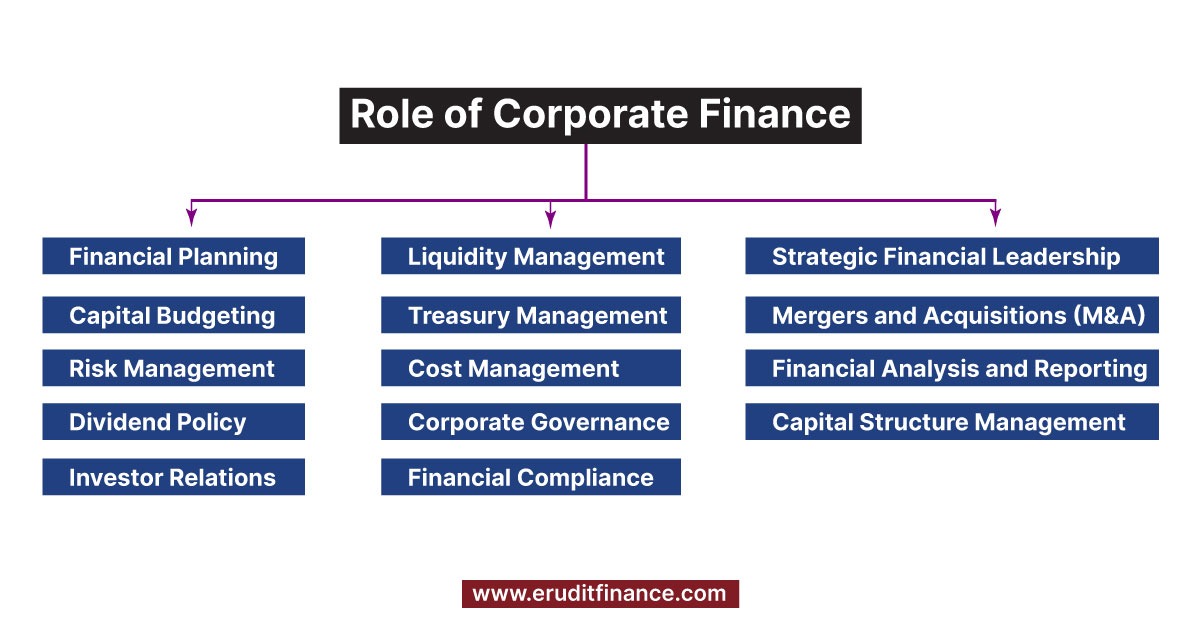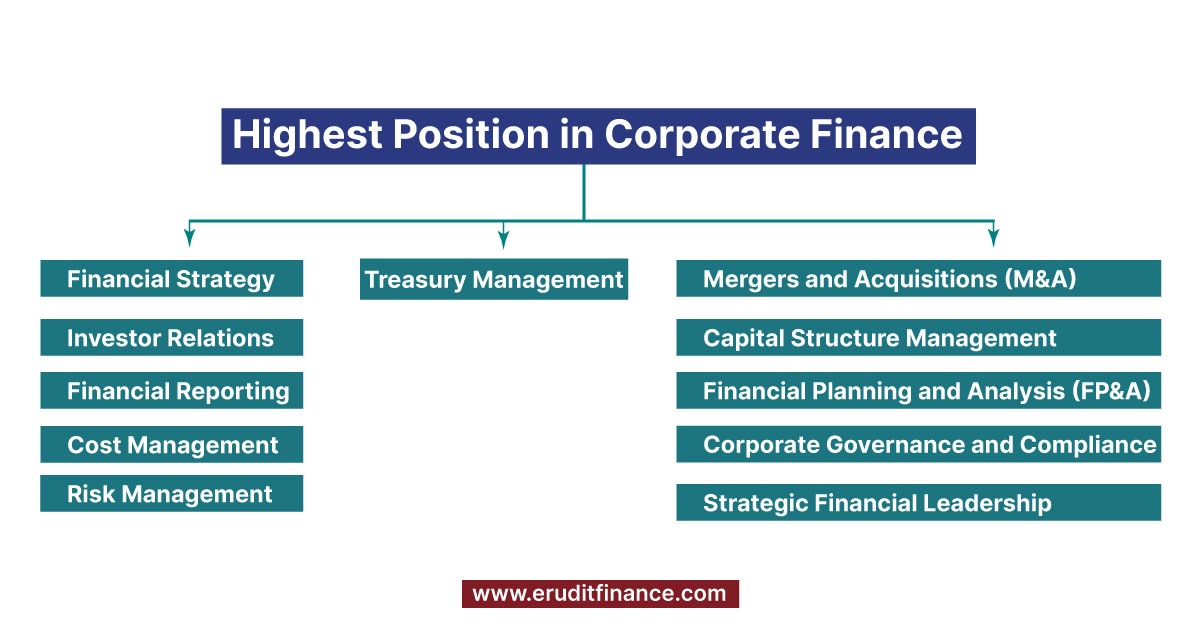Introduction to Corporate Finance Roles
Managing the financial strategy, capital structure, and investment decisions of a company are key duties for Corporate Finance Roles. These professionals help the company solve financial problems, optimize resources, and create value. They play a very important role in promoting overall company finance health as well as the performance of their units respectively. Financial analysts, treasurers, risk managers, and chief financial officers (CFOs) are key positions.
These experts work together on financial planning, evaluate investment targets, manage liquidity, and facilitate compliance. Their joint efforts define the company’s financial strategy–not just for profit, but sustainable growth and shareholder value. Roles in corporate finance involve a combination of analytical duties, strategic thought, and the ability to adapt as all facets have their unique dynamics. It is always changing the environment between financial markets and business environments.
What Is the Role of Corporate Finance?
The role of corporate finance is multifaceted, encompassing financial planning, decision-making, and resource optimization to enhance a company’s overall financial health and value. Key aspects of the role include:

| Financial Planning | Financial Analysis and Reporting | Treasury Management |
| Capital Budgeting | Dividend Policy | Cost Management |
| Capital Structure Management | Mergers and Acquisitions (M&A) | Corporate Governance |
| Risk Management | Financial Compliance | Strategic Financial Leadership |
| Liquidity Management | Investor Relations |
Financial Planning: Developing strategic financial plans that align with the company’s objectives, ensuring sufficient capital for operations, growth initiatives, and risk management.
Capital Budgeting: Evaluating and prioritizing investment opportunities to allocate capital efficiently. This involves assessing the profitability and risk of potential projects.
Capital Structure Management: Determining the optimal mix of debt and equity to fund the company’s operations and projects, considering the cost of capital, risk tolerance, and financial flexibility.
Risk Management: Identifying, assessing, and managing financial risks to safeguard the company’s assets and maintain financial stability. This includes currency risk, interest rate risk, and commodity price risk.
Liquidity Management: Ensuring the availability of adequate liquidity to meet short-term obligations and capitalize on strategic opportunities while minimizing the cost of holding excess cash.
Financial Analysis and Reporting: Conducting financial analysis, preparing reports, and communicating financial performance to internal and external stakeholders, supporting informed decision-making.
Dividend Policy: Formulating and executing dividend policies, balancing the return of value to shareholders with the need for retained earnings for growth and investment.
Mergers and Acquisitions (M&A): Assessing and executing M&A opportunities, including due diligence, valuation, and financial structuring to enhance shareholder value through strategic acquisitions.
Financial Compliance: Ensuring compliance with financial regulations, accounting standards, and legal requirements to maintain the company’s reputation and financial integrity.
Investor Relations: Engaging with investors, analysts, and the financial community to communicate the company’s financial performance, strategy, and prospects.
Treasury Management: Managing the company’s treasury functions, including cash management, debt issuance, and investment decisions to optimize financial resources.
Cost Management: Implementing cost-control measures, analyzing cost structures, and identifying areas for efficiency improvement to enhance profitability.
Corporate Governance: Upholding principles of corporate governance, transparency, and ethical financial practices to build trust among stakeholders.
Strategic Financial Leadership: Collaborating with executive leadership to provide strategic financial insights and guidance, influencing key decisions that impact the company’s overall performance.
In summary, the role of corporate finance is essential in steering a company’s financial strategy, managing resources, and creating value for stakeholders. Professionals in corporate finance contribute to the long-term success and sustainability of the organization by ensuring effective financial management and decision-making.
What Is the Role of Corporate Finance Manager?
The role of a Corporate Finance Manager is crucial in overseeing financial activities, strategic planning, and decision-making within a company. Key responsibilities include:
| Financial Planning and Analysis (FP&A) | Mergers and Acquisitions (M&A) | Strategic Financial Leadership |
| Capital Budgeting | Investor Relations | Team Management |
| Capital Structure Management | Treasury Management | Continuous Improvement |
| Risk Management | Cost Management | Financial Reporting |
| Compliance and Corporate Governance | Dividend Policy | Liquidity Management |

- Financial Planning and Analysis (FP&A): Develop and implement financial plans, budgets, and forecasts. Conduct thorough financial analysis to support strategic decision-making.
- Capital Budgeting: Evaluate investment opportunities, conduct cost-benefit analyses, and prioritize projects to optimize the allocation of financial resources.
- Capital Structure Management: Determine the appropriate mix of debt and equity financing, considering the cost of capital, risk, and financial flexibility.
- Risk Management: Identify, assess, and manage financial risks, including market risks, currency risks, and interest rate risks.
- Liquidity Management: Ensure the company maintains sufficient liquidity to meet short-term obligations and capitalize on strategic opportunities.
- Financial Reporting: Oversee the preparation of financial reports, providing insights into the company’s performance for internal and external stakeholders.
- Mergers and Acquisitions (M&A): Lead or assist in M&A activities, including due diligence, financial modeling, and negotiation to support growth and strategic initiatives.
- Investor Relations: Engage with investors and analysts, communicating the company’s financial performance, strategy, and future outlook.
- Treasury Management: Manage treasury functions, including cash management, debt issuance, and investment decisions to optimize financial resources.
- Cost Management: Implement cost-control measures, analyze cost structures, and identify opportunities for efficiency improvement.
- Dividend Policy: Develop and execute dividend policies, balancing the return of value to shareholders with the need for retained earnings.
- Compliance and Corporate Governance: Ensure compliance with financial regulations, accounting standards, and ethical financial practices. Uphold principles of corporate governance.
- Strategic Financial Leadership: Collaborate with executive leadership, providing financial insights and recommendations to influence strategic decisions.
- Team Management: Lead and manage a finance team, providing guidance, mentorship, and ensuring the team’s effectiveness in achieving financial objectives.
- Continuous Improvement: Identify opportunities for process improvement and implement best practices in financial management.
A Corporate Finance Manager plays a pivotal role in shaping the financial strategy of a company, contributing to its financial health, and supporting its growth objectives through effective financial management and strategic decision-making.
What Is an Example of Corporate Finance?
An example of corporate finance is a company deciding to issue bonds to raise capital for a major expansion project. In this scenario:
| Decision-Making: The company’s management evaluates the need for additional capital to fund the expansion and determines that issuing bonds is a suitable financing option. |
| Capital Structure Management: Corporate finance professionals analyze the company’s current capital structure, considering existing debt and equity, and decide on an optimal mix that includes issuing bonds. |
| Risk Management: The team assesses the risks associated with taking on additional debt, including interest rate risk and the impact on the company’s credit rating. |
| Financial Planning: Financial models are created to project cash flows, assess the affordability of debt repayments, and evaluate the long-term financial impact on the company. |
| Investor Relations: The company communicates its decision to issue bonds to potential investors through investor relations activities, providing information about the project, financial health, and the terms of the bond issuance. |
| Financial Reporting: Financial reports are prepared to update stakeholders, including current and potential investors, on the company’s financial performance and the purpose of the bond issuance. |
| Treasury Management: The treasury department manages the issuance process, ensuring efficient use of the funds raised, optimizing cash flows, and minimizing financial risks. |
| Compliance: Corporate finance professionals ensure compliance with regulatory requirements, financial standards, and ethical considerations throughout the bond issuance process. |
This example illustrates how corporate finance principles are applied in making financing decisions, managing capital structure, assessing risks, and strategically using financial instruments to support the company’s growth and expansion objectives.
What Is the Corporate Finance Structure?
The corporate finance structure refers to the framework and components that collectively govern a company’s financial activities and decisions. It encompasses various elements, including:
a). Financial Planning: The process of setting financial goals, creating budgets, and formulating strategic plans to achieve the company’s objectives.
b). Capital Structure: The mix of debt and equity used to finance the company’s operations and investments. It involves decisions on how much debt the company should take on relative to equity.
c). Financial Management: The overall management of the company’s finances, including cash flow management, working capital management, and investment decisions.
d). Risk Management: The identification, assessment, and mitigation of financial risks that may impact the company’s performance. This includes market risks, credit risks, and operational risks.
e). Corporate Governance: The rules, practices, and processes by which a company is directed and controlled. It ensures transparency, accountability, and ethical conduct in financial decision-making.
f). Financial Reporting: The preparation and communication of financial information to internal and external stakeholders, providing insights into the company’s financial performance.
g). Investor Relations: The communication and interaction with shareholders, analysts, and the broader financial community to build trust and provide information on the company’s financial health and strategy.
h). Treasury Management: The management of the company’s treasury functions, including cash management, liquidity management, and decisions related to short-term and long-term investments.
i). Dividend Policy: The formulation and execution of policies regarding the distribution of profits to shareholders in the form of dividends. It involves balancing shareholder returns with the need for retained earnings.
j). Mergers and Acquisitions (M&A): The evaluation, negotiation, and execution of mergers, acquisitions, or divestitures to enhance the company’s strategic position and create value for shareholders.
k). Cost Management: The implementation of cost-control measures and efficiency improvements to optimize operational costs and enhance profitability.
l). Financial Compliance: Ensuring compliance with financial regulations, accounting standards, and legal requirements to mitigate legal and financial risks.
m). Financial Analysis: The use of financial tools and analysis techniques to assess the company’s financial health, performance, and trends.
n). Strategic Financial Leadership: The role of financial leaders, such as the Chief Financial Officer (CFO), is to provide strategic financial insights, influence key decisions, and align financial goals with overall business objectives.
The corporate finance structure is dynamic and evolves based on the company’s size, industry, and growth stage. Effective management of these components is essential for ensuring the company.
Is M&A Part of Corporate Finance?
Yes, mergers and acquisitions (M&A) are integral parts of corporate finance. M&A activities involve the buying, selling, or combining of companies to achieve strategic objectives, enhance market position, or create synergies. In the context of corporate finance, M&A plays a crucial role in shaping a company’s financial strategy and contributing to its overall growth and value creation.
Key aspects of M&A in corporate finance include:
- Strategic Planning: Incorporating M&A as part of the company’s strategic planning to identify opportunities for expansion, diversification, or consolidation in the market.
- Financial Analysis: Conducting financial analysis, including valuation, to assess the financial health and potential benefits of the target company in alignment with the acquiring company’s goals.
- Capital Structure Considerations: Evaluating the impact of M&A on the acquiring company’s capital structure, considering how the transaction will be financed, whether through cash, stock, or a combination of both.
- Risk Assessment: Identifying and managing financial, operational, and regulatory risks associated with the M&A transaction to ensure a smooth integration process.
- Financial Modeling: Developing financial models to project the expected financial outcomes of the merger or acquisition, helping stakeholders make informed decisions.
- Due Diligence: Conducting thorough due diligence to assess the legal, financial, operational, and cultural aspects of the target company before finalizing the deal.
- Financing Arrangements: Structuring the financing arrangements for the M&A transaction, which may involve obtaining loans, issuing new equity, or using a combination of financial instruments.
- Integration Planning: Planning for the integration of the acquired company into the acquiring company’s operations, including combining financial systems, optimizing resources, and realizing synergies.
- Stakeholder Communication: Effectively communicating the financial rationale and strategic benefits of the M&A to various stakeholders, including shareholders, employees, and regulatory bodies.
- Post-Merger Financial Management: Managing the financial aspects of the combined entity post-merger, ensuring the realization of synergies, monitoring financial performance, and adapting financial strategies as needed.
M&A activities require a comprehensive understanding of corporate finance principles, including valuation techniques, risk management, and strategic financial planning. Successful M&A execution contributes to a company’s competitiveness, market share, and overall financial success.
What Is the Highest Position in Corporate Finance?
The highest position in corporate finance is typically the Chief Financial Officer (CFO). The CFO is a C-level executive responsible for overseeing the financial activities, strategies, and performance of an organization. As a key member of the executive leadership team, the CFO plays a critical role in shaping the financial direction of the company.
Key responsibilities of a CFO in corporate finance include:
| Mergers and Acquisitions (M&A) | Financial Strategy | Cost Management |
| Capital Structure Management | Investor Relations | Risk Management |
| Financial Planning and Analysis (FP&A) | Financial Reporting | Strategic Financial Leadership |
| Corporate Governance and Compliance | Treasury Management |

Financial Strategy: Developing and implementing the company’s overall financial strategy, aligning with business objectives and goals.
Capital Structure Management: Making decisions regarding the company’s capital structure, including the mix of debt and equity, to optimize financing and support growth.
Financial Planning and Analysis (FP&A): Leading financial planning and analysis efforts, including budgeting, forecasting, and financial modeling, to support strategic decision-making.
Risk Management: Identifying and managing financial risks, including market risks, operational risks, and regulatory risks, to safeguard the company’s financial health.
Investor Relations: Engaging with investors, analysts, and the financial community to communicate the company’s financial performance, strategies, and prospects.
Mergers and Acquisitions (M&A): Overseeing M&A activities, including due diligence, financial analysis, and integration planning, to support the company’s growth and expansion initiatives.
Financial Reporting: Ensuring accurate and timely financial reporting, both internally and externally, in compliance with regulatory requirements and accounting standards.
Treasury Management: Managing the company’s treasury functions, including cash management, liquidity management, and capital allocation.
Cost Management: Implementing cost-control measures and efficiency improvements to optimize operational costs and enhance profitability.
Corporate Governance and Compliance: Upholding principles of corporate governance, and ethical financial practices, and ensuring compliance with financial regulations and legal requirements.
Strategic Financial Leadership: Collaborating with other executives to provide strategic financial insights, influence key decisions, and contribute to the overall success of the organization.
The CFO is a top-level executive with a broad and strategic role, and their influence extends beyond finance to impact the overall business strategy and operations. The CFO reports directly to the CEO and often serves as a key advisor to the board of directors.
Bottomline:-
In corporate finance, roles are diverse and crucial for a company’s financial health. From financial analysts and treasurers to CFOs, professionals manage financial planning, risk, M&A, and compliance, contributing to strategic decisions and overall success. Their responsibilities span capital structure management, investor relations, and financial reporting. These roles require expertise in financial analysis, due diligence, and strategic financial leadership. Ultimately, these professionals play vital parts in optimizing resources, enhancing profitability, and shaping a company’s financial strategy for sustained growth.
Also Read:-










